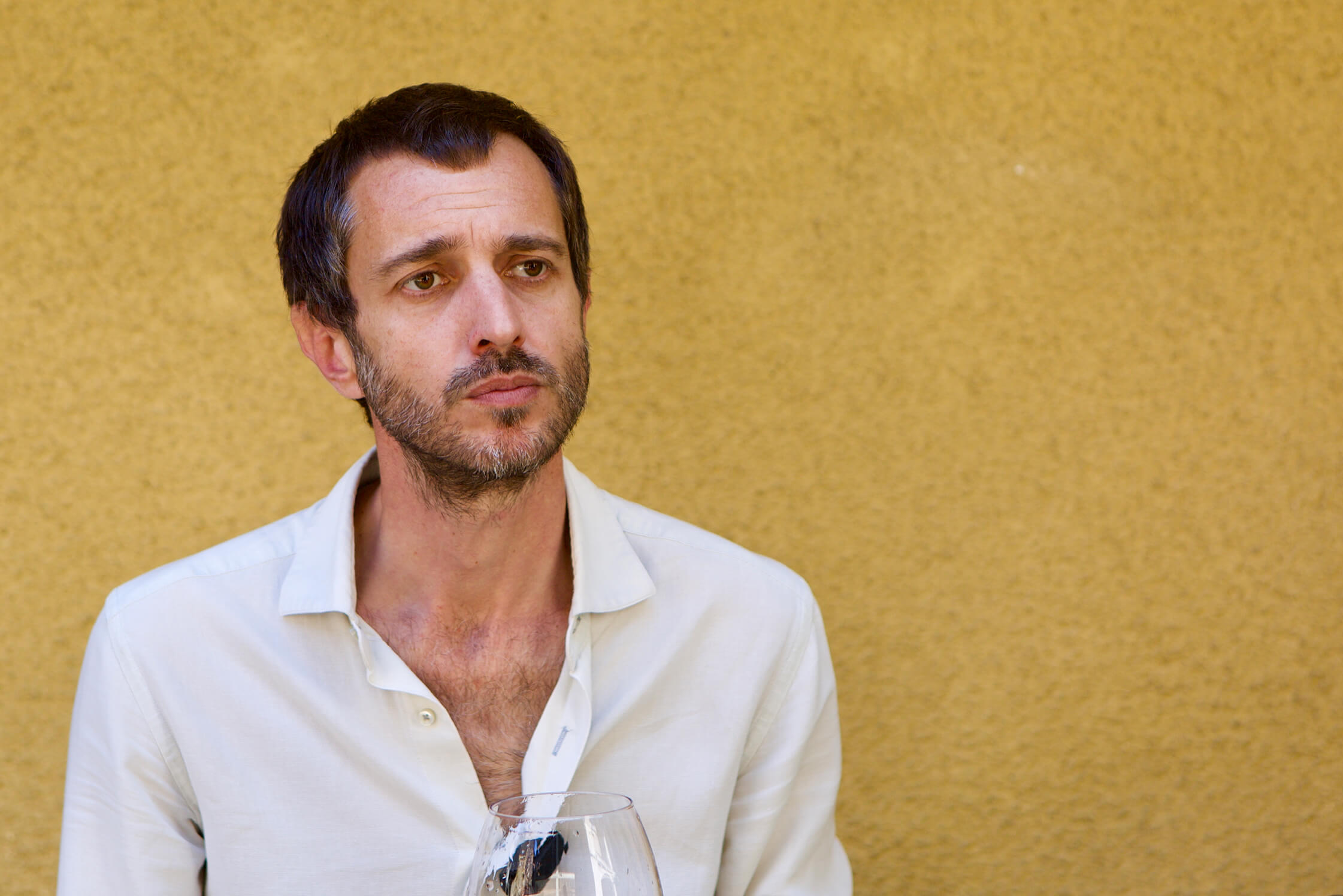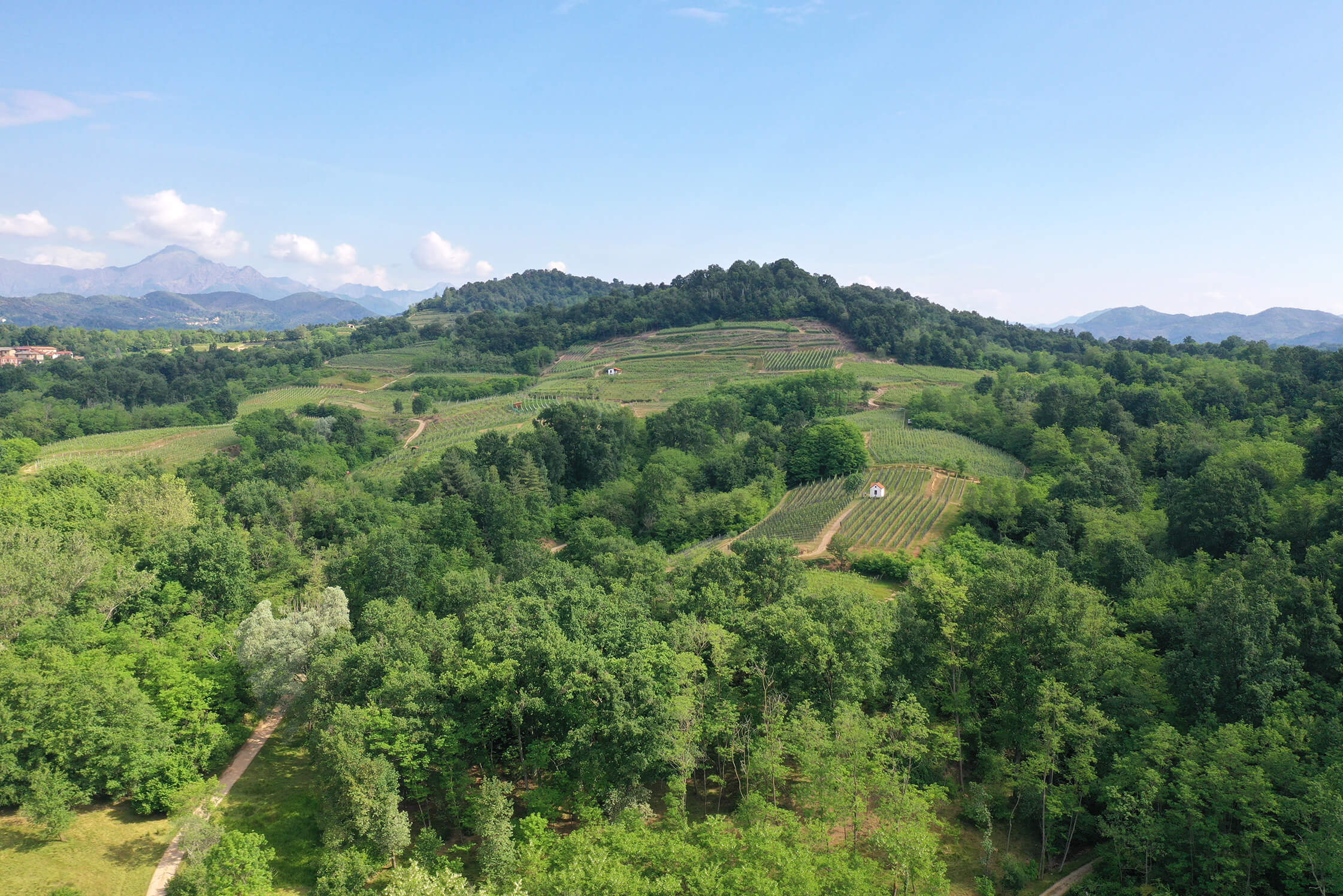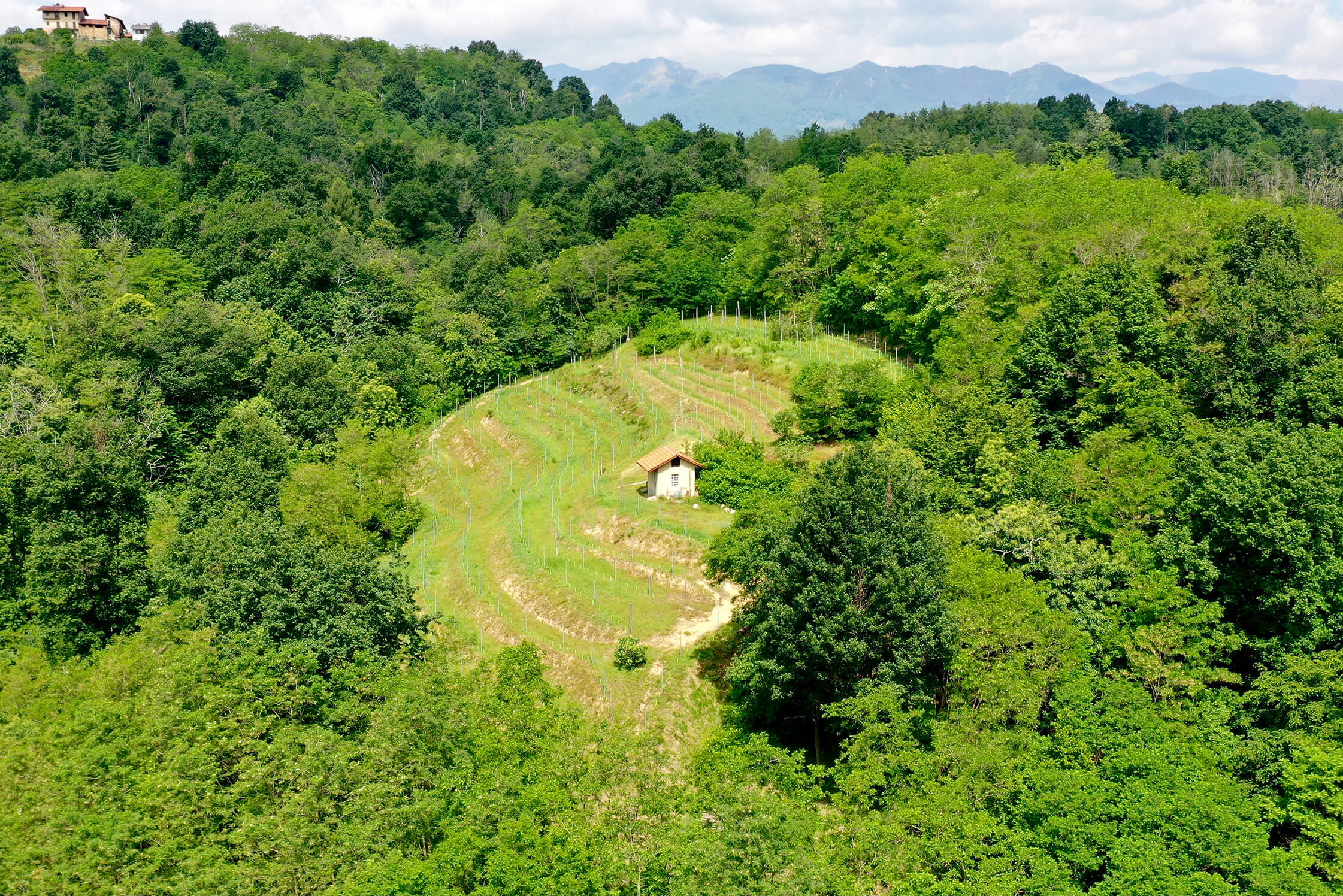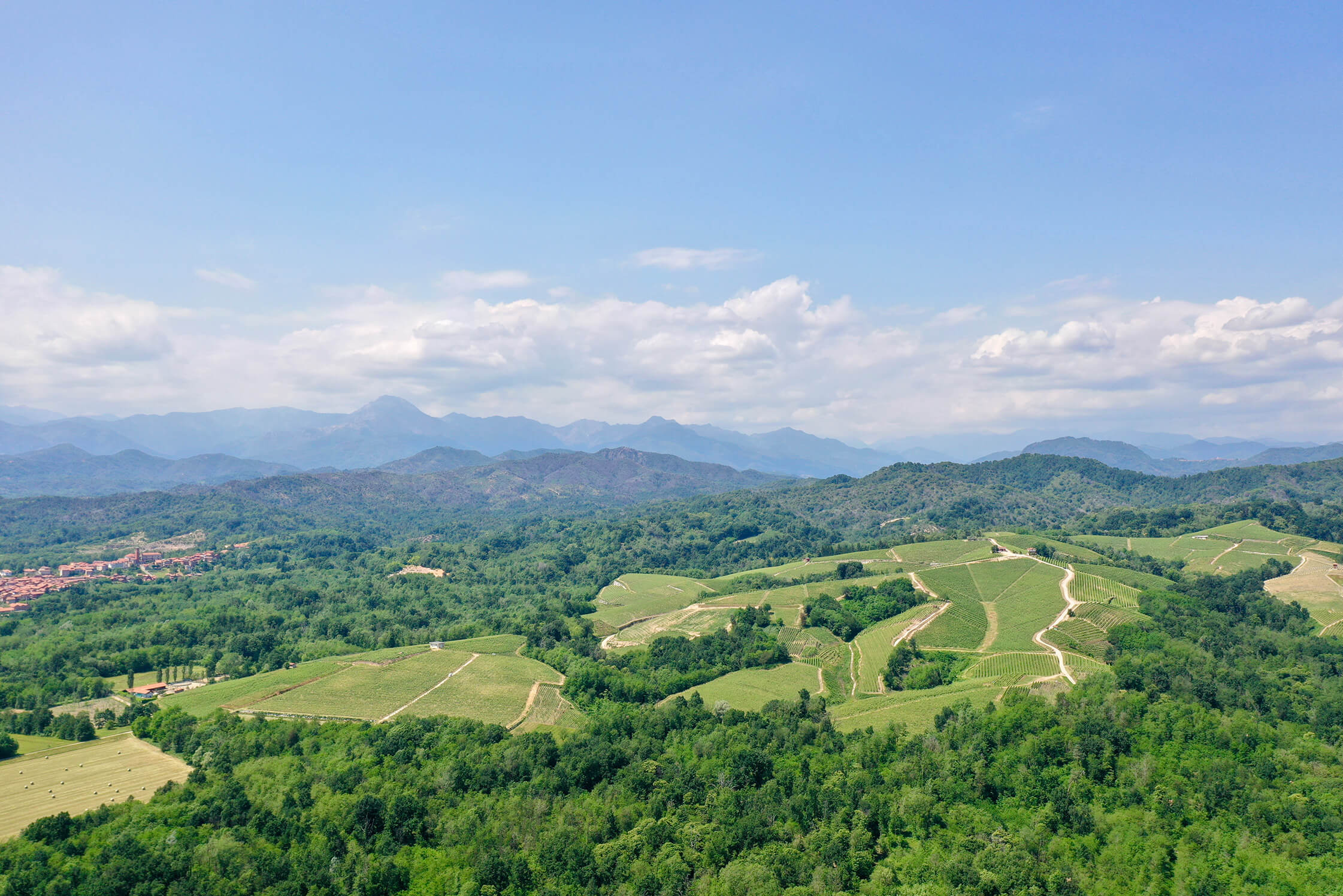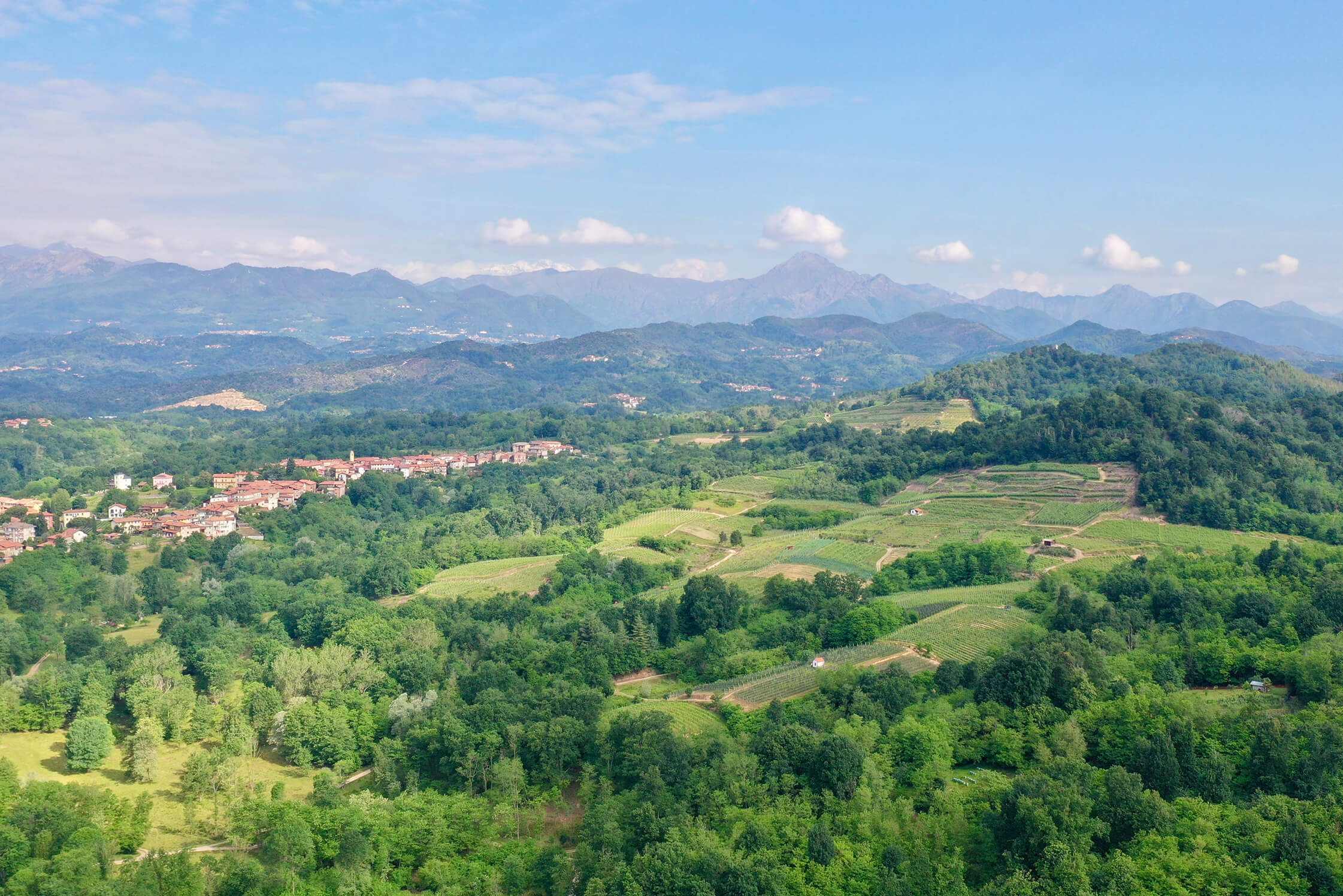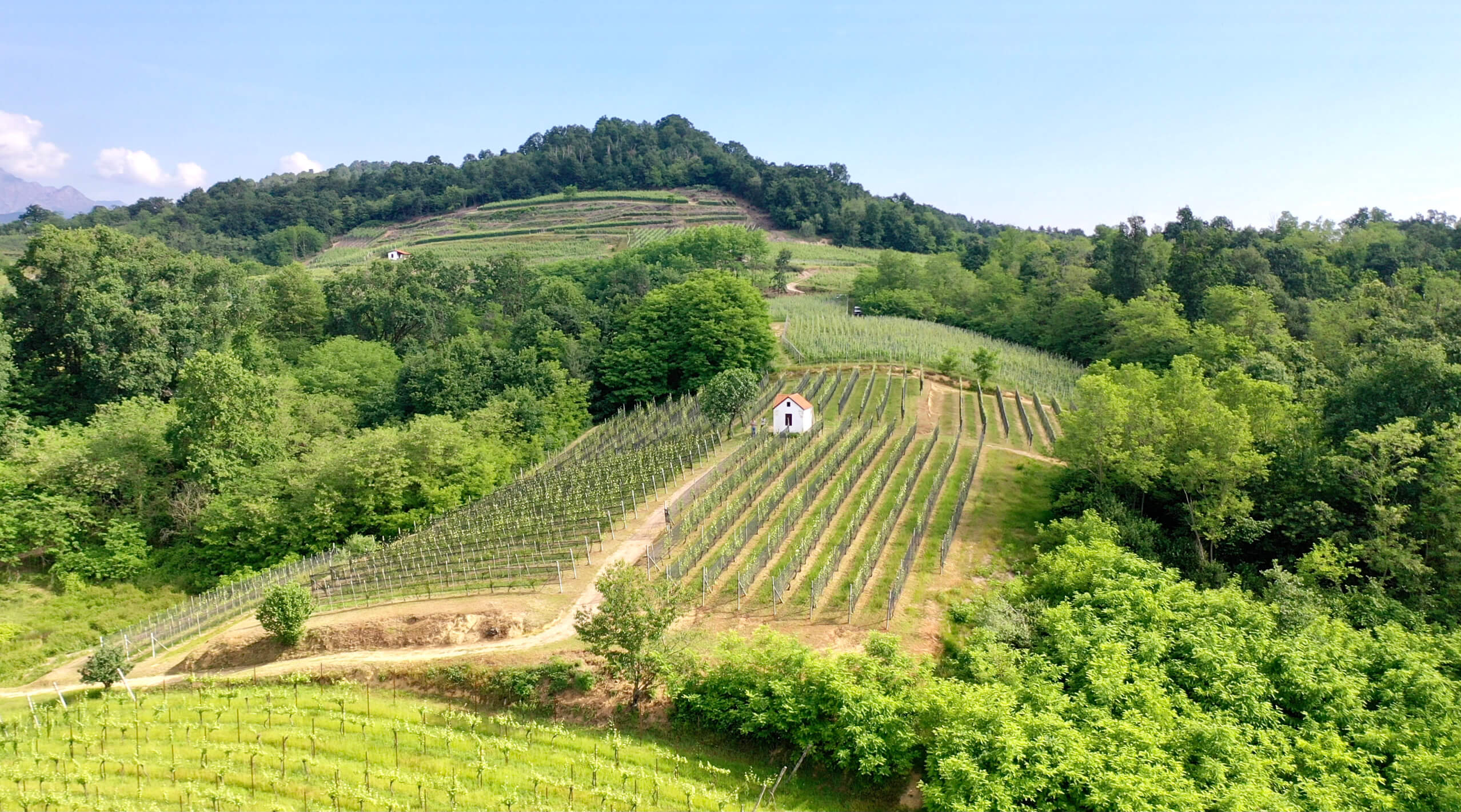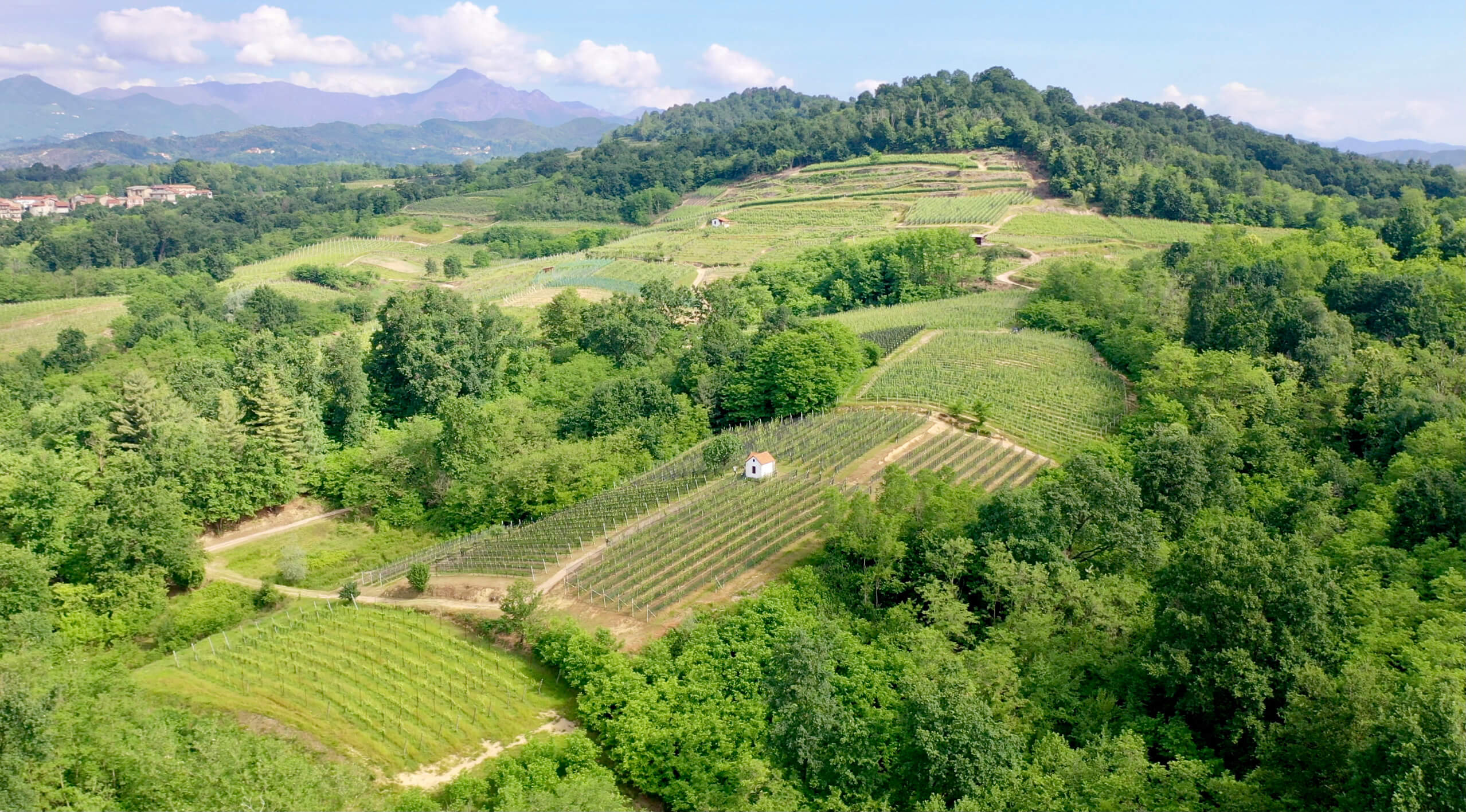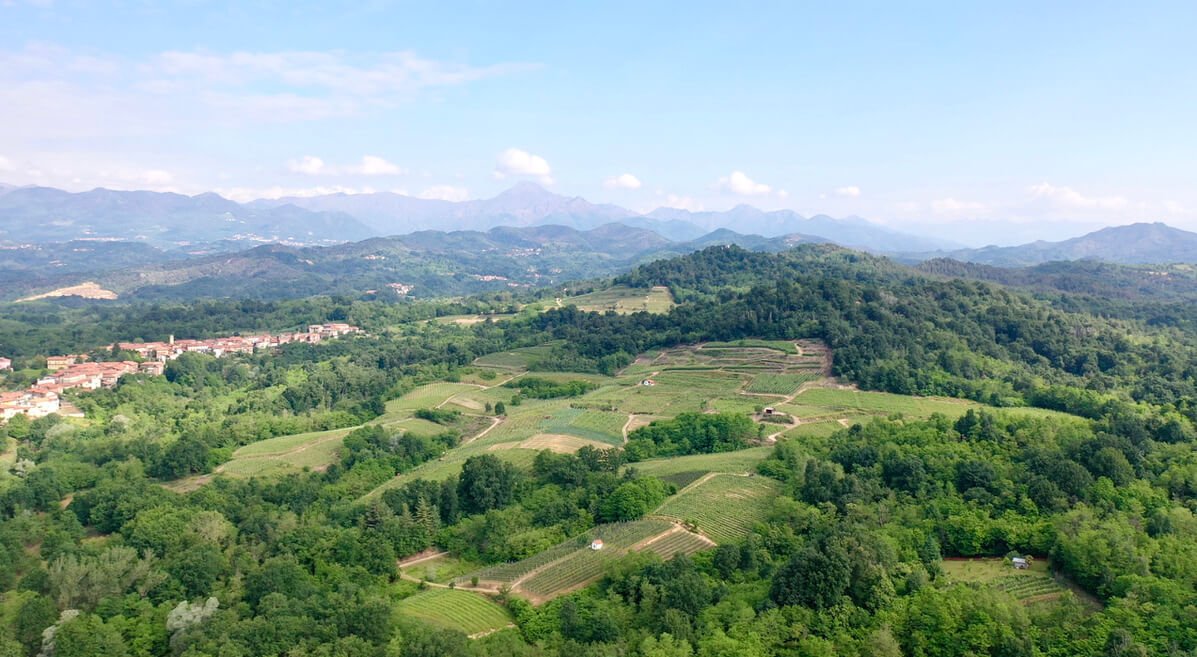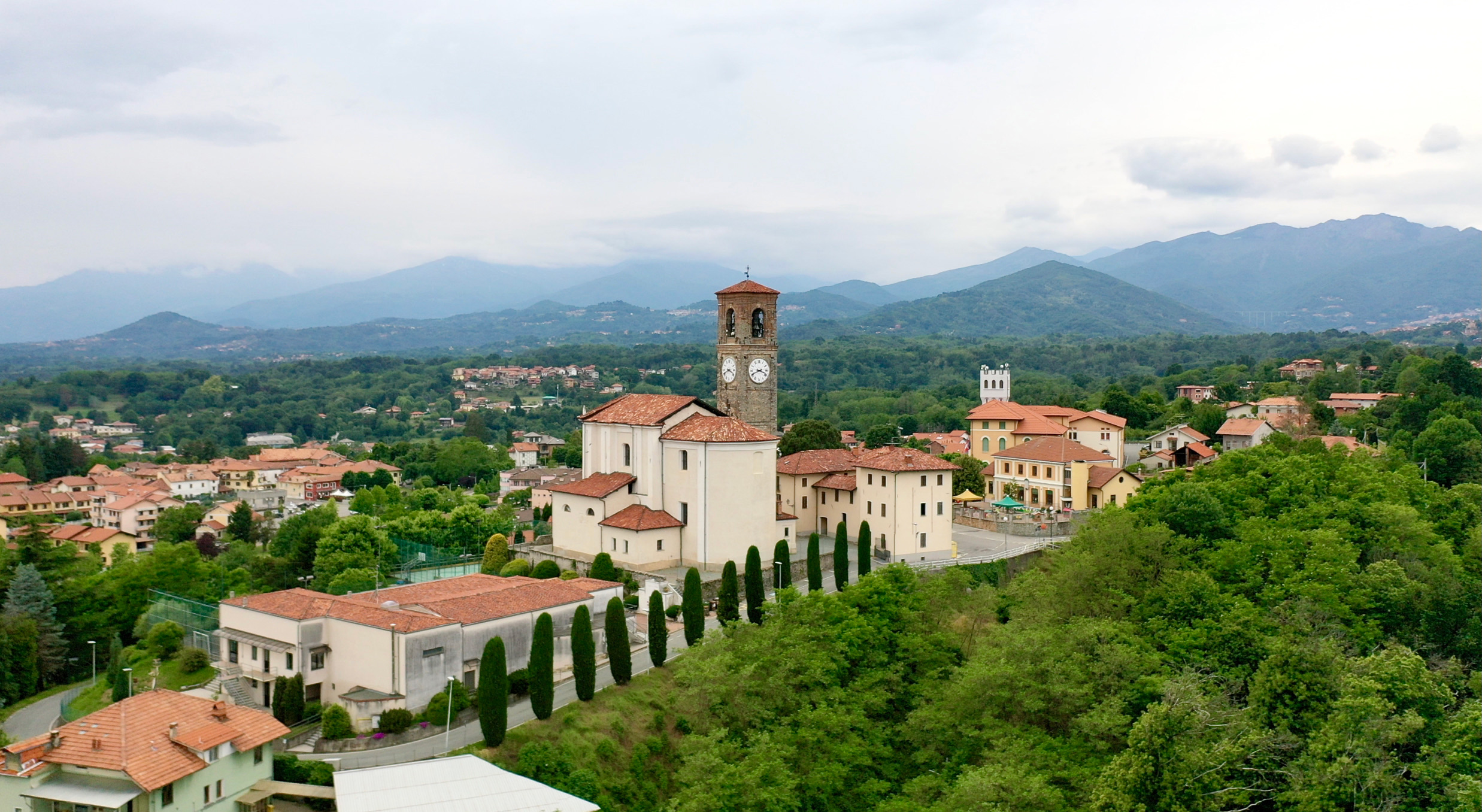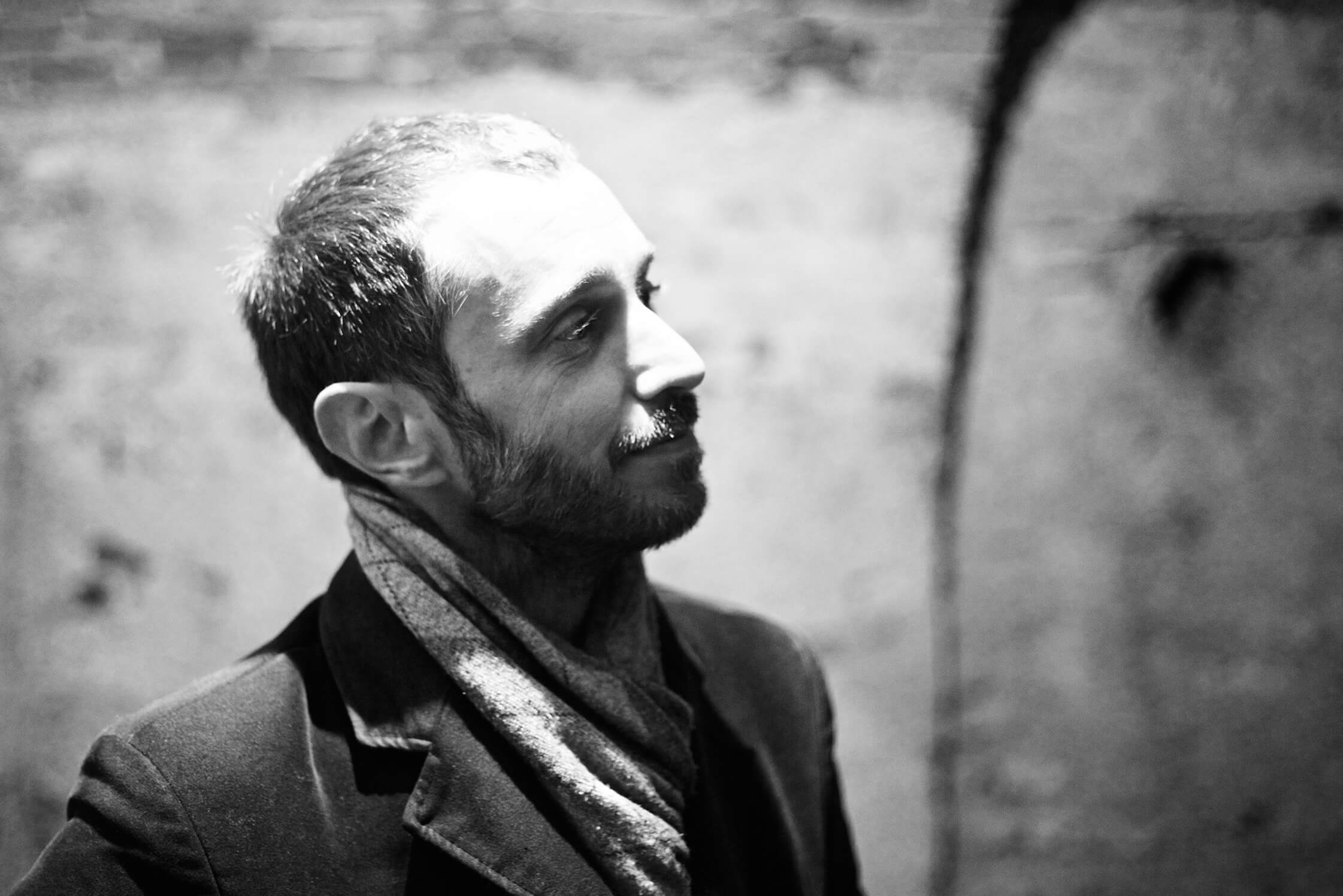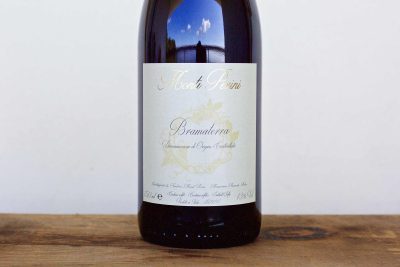Andrea Monti Perini
Full Length Story
Twenty days after his birth in Biella, Italy, in 1978, Andrea Monti Perini was on a flight to Africa. Natives of Masserano, a commune of the DOC Bramaterra, in northern Piemonte, Andrea and his family spent his first nine years in Nigeria for his father’s work, but after too many years of constant civil unrest in the region, they finally returned to Italy. Following primary school and student exchange programs in France and Spain, Andrea attended the University of Novara, where he studied economics and did his final thesis on the wine history of Biella.
Quick-witted, with a heavily Italian-inflected accent but a perfect grasp on the English language, Andrea’s clever tongue delivers subtle, dark, cynical, often self-deprecating and perfectly timed Italian color commentary right on cue, though it comes so fast that if you’re not paying attention at all times, the clever nuances and subtext can be easily missed. He has a lanky build, a stage actor’s expressive use of body language and a face that clarifies the mood of an anecdote with as few words as possible. His connection and passionate interest in history and culture makes for interesting conversation and perspective. At just over forty years old, he’s already lived a very atypical life that’s more deeply connected to the world than the average native Italian living in the backcountry.
The following text includes an abridged historical account of the Alto Piemonte and its connection to Biella, as recounted by this hobby-wine-historian turned winemaker.
The Fall and Rise of the Alto Piemonte
The story of Piemonte wine begins with the Romans. The vinous epicenter for almost two millennia in what is referred to today as the Alto Piemonte, or “high place at the foot of the Alps,” is in stark contrast to today’s most celebrated Piemonte wine regions further south in the Langhe hills, home of the famous Nebbiolo hot spots of the last century or so, Barolo and Barbaresco. The Romans could grow wine anywhere, and wherever they set up shop, vines were sure to follow.
The Elvo River, a short forty-mile tributary that begins in the lower Alps, is rich in gold—or at least it was before the Romans came along around two hundred years BC—and people still pan the river today in search of gold flake and nuggets. The Romans moved north in their conquests after the Punic wars and advanced on the Salassi, a mountain people in control of the Bessa gold mine close to the Elvo. The Romans won, seized control of the mines and set up a new central hub at what is today’s Aosta in order to be better situated to control the mountain areas and the road to Gaul as they began their conquests further north and toward the west.
Before the nineteenth and twentieth centuries, when a series of especially catastrophic events began to reshape the land and the mentality of its people, the Alto Piemonte wine production zone was larger than the modern day Langhe and Monferrato regions, combined. Those problems started with the arrival of the root louse, phylloxera, and the mildews, Powdery (simply called mildew, in Italian) and Downey (peronospera, in Italian). Almost half a century passed before solutions came about to manage these occurrences, but then a hailstorm of biblical proportions in 1904 completely destroyed the region’s recently replanted vines. After this demoralizing final natural catastrophe, it was man’s turn to further wreak havoc with back-to-back World Wars that devastated the population along with any remaining economic strength and willpower of this ancient wine community.
Biella was one of the ten wealthiest regions in Italy in the nineteenth century. When this series of unfortunate episodes began, many of the field workers left to join the region’s famous textile industry, which offered regular pay and made many people wealthy. Biella is home to perhaps the most famous luxury brand in the province, Ermenegildo Zegna, more simply known as Zegna, which began in 1910.
Alto Piemonte: The Ancient Origin of Barolo and Barbaresco
Along with the draw toward textiles in favor of the constant troubleshooting of agriculture, a mass emigration of poor Piemontese went to South America before the World Wars, most notably to Argentina, where you’ll find pasta, steak and wine, all very similar to Piemontese food. After the Great Wars, Northern Italy became the industrial center of the country and the Alto Piemonte, sandwiched between Milan and Turin, lost almost the entirety of what remained of its workforce to these cities. Forests and pastures reclaimed the former glory of Italy’s historic land of Nebbiolo along with its supporting cast of Vespolina and Croatina, and probably many more different grape types. During this time, all agriculture in the area decreased, not only wine. Around the time that the Alto Piemonte had all but completely disappeared, the Langhe wine region slowly began to prosper and by the mid-1900s it began to flourish with still, Secco Secco (dry) Nebbiolo wines, a term coined by the late Beppe Colla and the precursor to today’s Nebbiolos produced in Barbaresco, Barolo and other Nebbiolo appellation wines.
During the end of the twentieth century the textile industry fell into crisis as a result of an increase in global competition, so the wine industry in the Alto Piemonte began to once again show signs of life. Many foreigners and Italian outsiders began to take interest and took over many of the ancient terraces inside the areas overgrown with wild forest. Until about twenty years ago, Tenuta Sella was the only surviving relic of commercial wine production from yesteryear, outside of Gattinara, and remained alone for the better part of the twentieth century. In Gattinara a few other historic cantinas still remain, which includes Travaglini and Nervi (recently purchased by Roberto Conterno), who collectively maintain about 80% of the production of the entire Gattinara appellation.
Anyone in the Italian wine business who hasn’t been living under a rock knows that over the last decade the Alto Piemonte has become a central focus for the rise of indigenous Italian wine regions, without much in the way of invading internationally successful grape varieties, like Cabernet Sauvignon, Merlot, Syrah, Chardonnay, etc. Now there are dozens of cantinas and it remains a very exciting place (at least regarding quality wines, not so much larger towns and small villages) that has attracted big names from the Langhe, like the previously mentioned Roberto Conterno, of the famous Barolo producer, Cantina Giacomo Conterno.
Winemaking and grape growing is a new practice for Andrea. His years in wine prior to starting his own project were spent traveling the world as the ambassador for the historic Gattinara estate, Travaglini, known for its rustic wines captured inside an oddly-shaped, asymmetrical yet Burgundy-like bottle that appears to have been made by a constantly tipsy bottle maker prone to repeating the same mistake millions of times. There, Andrea learned how the global wine market functions, but it was not enough for him. Prior to 2015, he met with Cristiano Garella, a local, well-known enologist, who encouraged Andrea to start his project and committed to helping him along the way. His first vintage was 2015 and this Bramaterra is nothing short of inspirational and a refreshing departure for a region known for wines that in their youth are dominated by deep, coarse textures. If 2015 and his superb follow-up vintage, 2016, are a sign of what is to come with wines made under the Monti Perini label, there is hardly a more promising prospect in all of the Alto Piemonte for those who prefer wines led by elegance over power.
Monti Perini Vineyard Practice
What’s most interesting about Andrea Monti Perini’s wines is their oppositional nature in relation to all others that I’ve tasted from Bramaterra. Andrea builds on the strength of his terroirs in a way that obviously focuses on finesse as a naturally guiding principal. His overarching interest is to prioritize authenticity in his wine by employing as many natural processes as possible along the way, while always applying properly managed enological principles.
“Unfortunately, we are not a Mediterranean island, so farming organically is extremely hard,” Andrea explained. In Monti Perini’s vineyard, 95% of everything is done by organic method and treatment, with some other methods employed in the remaining 5%, or less. A portion of the latter includes methods that prevent the spread of a particular insect, mandated by the Italian government, with the remainder composed of treatments for extreme mildew issues during problematic seasons. The region suffers greatly (far more than average) from mildew pressure, which requires a lot of treatments when under organic methods; likely too many treatments in this green land full of thick, humid, alpine foothill forests. During especially difficult years, Andrea remains flexible if business-saving decisions are necessary. In any event, all the soil treatments in his vineyards are organic—things such as fertilizers, amendments, etc, and every process in the vineyard and cellar is done exclusively by Andrea Monti Perini’s own hands.
It is indeed easy to criticize those in the fine wine world who don’t make any effort to utilize a more nature-friendly defense against pests, as it is in the vast majority of Germany, France, Italy, and Spain. Alto Piemonte is far from one of the easy places to be an exception to this rule and given the wine prices most growers are able to fetch and the limited production in the area, it is especially hard to make a living. Add to this the modest global interest in the wines, which is slowly but steadily growing—though even many of the Piemontese people don’t know much about wine in this area. To that point, I met a very nice Italian man living in Portugal who was from Torino, the capital of Piemonte, and he proclaimed to be passionate about Nebbiolo but didn’t have a clue what I was talking about when I mentioned the wines from Alto Piemonte, and that’s only an hour away by car from where he spent the first sixty years of his life!
Before the foreign invasion of phylloxera, followed by Powdery and Downey mildew, there was no need to work against these scourges, so things could be managed in an entirely natural way—the only way up until that time. Things are obviously different today; we live in an industrial and mechanized world of mass production, so to force these puritanical, rigid and ideological standards on every small grower when their livelihood is at stake is a dubious approach at best, rife with selective hypocrisy and unfair and ignorant expectations. Andrea, like many growers in high-mildew-pressure areas, does his best each season and we applaud him for taking the measured risks that walk the thin line between disaster and success. We believe that without those risks, his beautiful, subtle and soft-edged wines, made by as many natural processes as possible within each wildly different vintage would be impossible to achieve with a standard, unconsciously industrial and mechanized approach. The best and most measured defense against the use of unnatural treatments is to have an active and very present winegrower in their vineyard at all times. This serves to manage small and localized challenges as they occur, rather than the need to carpet bomb with damage control treatments after things have already gotten out of control.
In the Cellar
The natural yeast co-fermentation of Nebbiolo (80%), with a field blend of Vespolina and Uva Rara that make up the rest, takes place in wooden vertical tronconic tanks (called tine, in Italian) to soften the natural edge of the wines produced in these metal-rich vineyards. Fermenting in tine is unusual in today’s local wine production where most people employ stainless steel, which tends to sculpt wines with harder lines and more stern tannins. However, a century ago, Piemonte was a significant producer of wooden barrels with one of the last producers, Gamba, still quite present in many cantinas in Piemonte. Veneta Botte is the producer of Andrea’s twenty-five hectoliter Slavonian oak tino (cleaned only by steam and brush) made from forests between Hungary and Croatia. The cap during fermentation is punched down by this one-man crew, two or three times per day over a three-week period. The fermentation temperature is not controlled during this time but the wood helps to regulate it, allowing for a maximum of around 28/29°C (82/84°F).
Depending on the year, cellar aging in wood lasts at least eighteen months (a requirement for the DOC Bramaterra), and up to twenty-four. Before bottling, the wine is lightly filtered (not sterile filtered) for clarity; no finings are used. Other than an occasional wine labeled Spanna (only in 2015 thus far), the final result from each vintage is a single Bramaterra: a soft-colored red wine with striking finesse and deep character, led with the aristocratic polish and profound depth of Nebbiolo from its most historic homeland. It doesn’t for a moment exhaust the palate, which holds true even in the absence of food—a rarity with Nebbiolo as the headliner in the mix. Andrea’s Bramaterra is the culmination of years of studying his regional culture and its wines. His finding the inspiration to create a wine designed to walk the line of finesse and beauty without sacrificing its noble breed or discarding important matiére is, to many such as myself, an enlightened level of craft usually found in the twilight of one’s winegrowing career, not the beginning, as is the case with Andrea Monti Perini.
Alto Piemonte & Langhe Comparison
Alto Piemonte is different from its more famous neighbors to the south in the Langhe areas, Barolo and Barbaresco, and it’s worthy of exploration in order to see how Nebbiolo wines from these general areas can be so very different. From a terroir perspective, they don’t have much of a relationship with regard to climate, viticultural setting and geology, but they are similar in that not only do they age effortlessly, they also continue to improve after a long time—some easily for decades before reaching the start of peak maturity.
Climate & Viticultural Setting
The Langhe is subject to a tug-of-war between the warmer, humid weather of the Mediterranean and the drier, cooler weather of the Alps. The vineyards are also exposed and situated—at least in the cases of Barbaresco, and even more, Barolo—inside a strongly monocultural environment dominated by the vine on nearly every ideal hillside exposure. Located between Milano and Torino, Alto Piemonte is foothill country, flanked by mountains and lakes to the north, and surrounded by hills and rivers. The mountains allow for cooler days than in Langhe, and the nights even more so. There’s significantly more rain, too, which often requires more treatments against the unwelcome dastardly duo of Downey and Powdery mildew. While there is no Mediterranean influence, it can be extremely humid, an influence from the dense forests and wild vegetation; some areas almost seem subtropical. Fortunately, the summers are typically hot and dry and the grapes are largely spared too much precipitation from July until harvest. Spring frosts and late season hail are always a threat in the area as well, adding more difficulties to an already challenged viticultural environment.
The climate also generates a longer growing season for Nebbiolo in Alto Piemonte than in the south, with a difference of a week or two on average, when factoring in the slightly later bud break of Alto Piemonte and its even later harvest. Perhaps a week doesn’t seem like much, but for Nebbiolo, a grape whose depth of complexity is predicated on a long growing season, an additional week is helpful to push colder years above the potential of 12% alcohol. By contrast, even in colder years most Langhe vineyards can easily push Nebbiolo alcohol levels above 14%, while still maintaining balanced phenolic maturity.
Geology
Geologically, Alto Piemonte and Langhe have almost nothing in common. Indeed they have a close proximity in distance and general time of geological development—that is, both were geologically defined within the same fifteen-million-year period—but that’s about it. The Langhe is an area of extremely soft limestone bedrock (if one can say there is a bedrock hard enough to call it a rock to start with) with a variable topsoil composition of calcium-rich sands and/or clay-rich marls, both derived from the bedrock below. With the support of full solar power on the most exposed aspects, warmer weather, and its alkaline soil that assists in keeping wine pH levels down, the Nebbiolo wines of the Langhe are far more powerful and alcoholic than the average Alto Piemonte Nebbiolo-based wine.
Alto Piemonte’s geological development was decidedly more volatile than the previously mentioned 100-years of major difficulties. It sits on the southern foothills of the Alps, a mountain range created by the continuing collision of the African and Eurasian tectonic plates. Through these orogenic processes, there was a lot of volcanic activity, and aside from the remnants of a volcanic explosion in the area that predates the Jurassic geological age (201.3 million to 145 million years ago) by nearly a hundred million years, the more recent volcanic activity laid the foundation for most of the region’s vineyards.
Alto Piemonte Notable Appellations
The regions divided by the Sesia River represent two very different geological settings. However, both are still on the opposite side of the spectrum from the Langhe in terms of soil and bedrock constitution and pH level. The Alto Piemonte’s bedrock and topsoil are extremely acidic (seemingly contributing to the increased perception of salty/saline character of the wines), while the Langhe’s limestone-derived rock and soil is heavily alkaline.
On the east side of Alto Piemonte, Ghemme is an appellation largely on moraine depositions (from glaciers) and Boca has hillside vineyards on igneous bedrock. On the west side, starting with Gattinara, known for its big rock outcrops and steeply terraced vineyards, it becomes much more geologically complex. The bedrock and topsoil in these areas are mostly on porphyry. This igneous rock is typically light and dark purple, reddish, orange, pink, and sometimes grey. It’s hard rock but still friable due to its large-grain mineral composition, similar to granite, but not specifically in its mineral composition. This makes it easy to break down with mechanical/physical and chemical erosion, making viticulture a natural fit. The small but very significant appellation of Lessona is composed mostly of yellowish orange marine volcanic sands and is known to produce very elegant and deeply complex wines.
Monti Perini’s Bramaterra Vineyards
Bramaterra is one of the largest appellations in Alto Piemonte. It’s composed of seven municipalities, starting with Lozzolo furthest east and Masserano furthest west and bordering the Lessona appellation, with Villa del Bosco, Curino, Sostegno, Roasio, and Brusnengo in between. The geology is somewhat variable within the seven communes but is a mix of igneous rocks.
The vineyards employed for Monti Perini’s first few vintages (2015-2018) are located at 400-450 meters in altitude on a southwest face within the commune of Brusnengo. The vines were planted in the 1980s on a property in Brusnengo historically known for exceptional wine—no surprise when one tastes Andrea’s wines. The blend of grapes in this vineyard is 80% Nebbiolo, with the remaining 20% composed of Croatina and Uva Rara .
The weather in Brusnengo is warm, but not the warmest area of Alto Piemonte (which still means it’s still not even close to as warm as Langhe). It’s windy in the summer, and there is very little threat of spring frosts once the buds have burst and the shoots are still small and fragile.
There is some variation between the bedrock and topsoil of his Brusnegno vineyard, despite its small, 2.5 hectares, with 1.5 of them currently planted (the remainder is still forest that he is slowly chipping away at alone, to make way for new vines). Some sections are sandier, others rockier, and some are impossible to plant because the bedrock has almost no topsoil. Most of the vineyard has exposed rock on the surface that is especially crumbly and soft, which quickly decomposes into sand, allowing the root systems to exploit this advantage by plunging deep into the soil. Despite their naturally low yield (likely due to the extreme pH of 4.0 acidity and heavy metal content of these volcanic soils that makes flowering difficult) this sandy soil renders wines naturally light in hue and body, which will appeal to those in search of wines led by more subtle nuances while still maintaining deep, complex layering.
Despite barely eking out a living with this small parcel of land, Andrea has recently added a new vineyard to his collection. It’s located in perhaps the warmest subzone of Alto Piemonte: Masserano—his family’s hometown, and the location of his tiny winery and underground cave. A medieval village, Masserano was founded around the year 1000 A.D, and between the sixteenth and eighteenth centuries it had links with the papal state. It’s still home to the Palazzo Ferrero Fieschi, the former palace of the Ferrero Fieschi family, who created their own mint to make currency. The wealthy and the church (also wealthy) had a knack for hanging around areas that produced top quality wines, and Masserano and the neighboring Lessona were no exception.
The general difference between these two communes and vineyards is that Brusnengo is a little cooler, while only three kilometers away, and with perhaps a touch more—but only slightly more—sandier soil. In the cave that holds Monti Perini’s single large botte, the residue of volcanic sediments are on display and evoke the image of a Rothko-esque layer-cake of deeply colored and damp alternating yellowish, orange volcanic sands, easily scratched away from the wall with bare fingers.
The future is bright for Alto Piemonte wines, and Andrea Monti Perini is a welcome new addition to this ever-rising tide. His wines are of the most elegant and progressive in a more natural way, by comparison to most in the region. They have a gentler demeanor than any youngish wines I’ve had from this part of Piedmont, save those from Lessona, the high-queen of Piemonte. The only challenge with Monti Perini is his minuscule production, a problem that will really come to the fore when the world discovers his talent and wants more from him.


